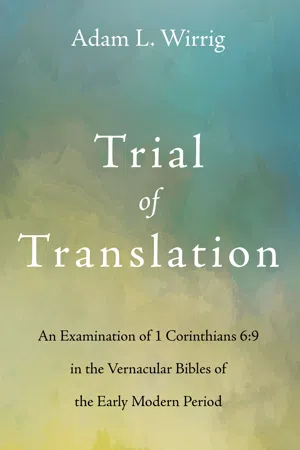![]()
Chapter One
Germany: Reformation, Reticence, and Indictment
Any examination of vernacular Bibles from the early modern period must begin with Martin Luther’s 1522 Neuen Testament. Luther’s vernacular testament was the first testament translated into German that did not rely on the Vulgate, but was instead an attempt to return ad fontes, to the sources, using the most scholarly editions of the original Greek and Hebrew texts. Moreover, while other vernacular Bibles appeared in Reformation Germany, most were largely based on Luther’s translation, thus giving Luther’s work predominance. Luther, as previously touched upon in the introduction, was interested in garnering a literal understanding of the biblical text but was also not outside the bounds of previous medieval methodology. Largely following the four-fold method of interpretation, Luther often simply amplified the literal and tropological senses rather than the anagogical or allegorical ones. Thus, one might posit that Luther was interested in creating a biblical interpretation that was both historically accurate and, at least in some respect, historically based on acceptable modes of translation. Ultimately, Luther’s goal was to convert the text into readable and understandable German, a German that could include both vernacular and colloquial renderings. This task, admirable though it might have been, brought about some considerable issues in the translation of problematic verses such as 1 Corinthians 6:9.
From the fourteenth century, at the very least, one of the common interpretative practices for problematic texts, particularly those that spoke of sexual sin, was to cloak interpretation or exegesis in obscurity, thus rendering them only transparent to the learned. This culture of secrecy, particularly regarding sex, derived from medieval German exegetes such as Berthold of Regensburg, Ulrich of Pottenstein, and Nikolaus of Dinkelsbuhl. All of these commentators advocated silence or reticence when discussing sexual deviancy or sins that were contra naturam (i.e., sodomy). In place of any direct dialogue concerning sexual sins, particularly those concerning the sodomitch, or sodomite, there were creative and colourful euphemisms. Generic terms from the Middle Ages, such as kezzer (heretic) or verwazenketzerie (damned heresy) were employed to discuss actions of sodomy and sins contra naturam. These terms did not refer to a specific person or action, but instead alluded to a nebular conceptualisation of construct. Luther’s translation both continued and departed from this previous practice, listing on one hand a nebulous type of person and, on the other, a new and very narrow understanding. Moreover, Luther’s translation, while incorporating ad fontes elements, was also less than explicit regarding how the reader might understand 1 Corinthians 6:9.
With reference to 1 Corinthians 6:9, Luther translated οὔτε μαλακοὶ οὔτεἀρσενοκοῖται as nocht die weichling und nocht die knabenschender. In this translation, Luther seems to have been painfully true to the apostle Paul, using both an equivalently imprecise word to translate the μαλακοὶand a neologism all his own for the ἀρσενοκοῖται. Taken at its most literal, the weiche was that which was soft, weak, or foolish. As with the original Koine term for the μαλακοὶ, the noun weiche could refer to physical, emotional, animate, or inanimate objects. While there were many options for defining the weiche, the knabenschender was another story entirely. The word knabenschender was a combination of the terms for “boy,” particularly a young boy, and “shame, abuse, the genitals, and stigma.” This compound neologism, by virtue of its root words, conjures up images of sex and sexuality, particularly pederasty, within the reader. Nonetheless, defining how, or if, Luther understood the term to imply a specific sort of sexual misconduct is problematic.
Contextualising Luther’s vernacular translation is a difficult enterprise. Although Luther seemed dedicated to providing a translation that was meaningful, applicable, and powerful, he was somewhat coy about exactly what he intended weiche and knabenschender to imply. The two terms, again, indicated those who would not inherit the Kingdom of Heaven; those who could, as it were, never be brought to salvation. Thus, one might expect Luther, as a pastorally minded reformer, to elucidate exactly what he understood these terms to mean for the average German. This, however, was simply not the case. Luther never discussed the weiche or the knabenschender directly within his entire corpus of writings. Thus, understanding who or what Luther himself meant his terms to mean is virtually impossible.
It is possible; perhaps even likely, that Luther was anticipating his audience to decipher his words via contextual and cultural clues. It is also equally probable that the text was not particularly important to Luther, as the Holiness Code of Leviticus provided ample fodder for sexual regulation for the reformers. Nonetheless, in the context of this study, Luther was frustratingly obscurantist about precisely who or what he intended the weichling, and particularly the knabenschender, to describe. Thus, one should note two things: firstly, Luther’s vernacular gave names to the malefactors in 1 Corinthians 6:9 and therefore adhered to the Protestant and humanist concept of ad fontes vernacular translation. Luther was again painfully true to the Pauline text by substituting neologism for neologism. Nonetheless, Luther seemed tacitly to follow previous conventions concerning certain sexual incontinence by never actually illustrating or detailing the terms in his vernacular.
While Luther was somewhat reticent about the purpose of his translations, the two terms did find lexic...
